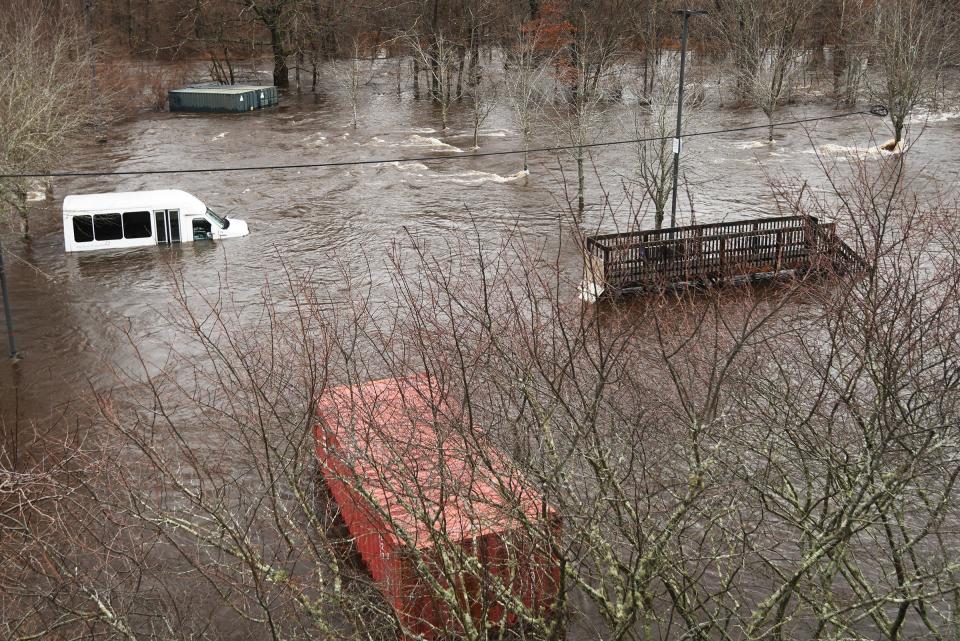After the Yantic River flooded last month, what's being done to prevent future damage?
The first step in preventing future flooding of the Yantic River could happen as early as April.
Leaders from Norwich, Sprague, Bozrah and Franklin met with the Southeastern Connecticut Council of Governments (SECCOG) on Feb. 7 for a first meeting about what can be done to prevent further flooding of the river. The process is expected to take years, but the first step, collaborating with UConn on a plan, is expected to start in April, SECCOG Director Amanda Kennedy said.
Having the towns collaborate is important when river flooding is “a problem that’s not going to get any better on its own,” Norwich Mayor Peter Nystrom said.

What the communities experienced in the January flood
SECCOG wants to know what people are experiencing, the options for flood mitigation, and what to prioritize.
Town leaders shared their experiences at the meeting. While Nystrom recalled cars being stuck in the Backus Hospital parking lot, Franklin First Selectman Alden Minder said debris was accumulating and plugging drainage basins, and Sprague First Selectman Cheryll Blanchard said smaller water sources off of the Yantic River flooded and caused problems in her town.
What assistance SECCOG will provide
There will be two ways in which SECCOG will study the problem and possible solutions. First is the collaboration with UConn’s Connecticut Institute for Resilience and Climate Adaptation (CIRCA) on the Yantic River Flood Mitigation Planning Process. CIRCA will provide $150,000 worth of technical assistance from April until March 2025. SECCOG will study community experiences, along with flood data and models, to create flood mitigation models and mitigation options, the document states.
SECCOG has also applied to the FEMA Building Resilient Infrastructure and Communities Program for the Yantic River Project Scoping Study. This will start in April 2025 and run for 18 months. It will cost $350,000, but is 75% grant funded. This study looks at a minimum of eight possible solutions and evaluates the technical components and the benefit-cost analysis.
The municipalities and large institutions, like Backus Hospital, will be asked for their input through a Technical Advisory Committee, Kennedy said.
Flood mitigation strategies
Possible mitigation strategies include floodplain and wetland restoration enhancements, voluntary property acquisitions, floodproofing and elevating buildings, modifying infrastructure, limited sediment removal, redesign or removal of dams and other obstructions, and earthen levee systems or other large-scale flood protection systems.
Some specific action items from SECCOG’s 2023 Hazard Mitigation and Climate Adaptation Plan include considering a flood mitigation study along the Yantic River for risks to properties and Stockhouse Road in Bozrah, providing FEMA grant information for the Yantic Volunteer Fire Department to help prevent building flooding, supporting additional park and trail systems in Norwich, floodproofing the Norwich Public Works utility room, and conducting study and design for reducing flood risk at the Bean Hill Substation.
Since damage at the Fitchville Pond Dam during the flooding caused concerns, the towns want to approach the owner, Seymour Adelman, in a helpful way, not wanting to tarnish his legacy, Nystrom said during the meeting.
“He’s done a lot of good things his whole life for this area of the state,” he said.
Thanks to our subscribers, who help make this coverage possible. If you are not a subscriber, please consider supporting quality local journalism with a Norwich Bulletin subscription. Here are our subscription plans.
This article originally appeared on The Bulletin: UConn helping stop future Yantic River flooding of Norwich, Bozrah

